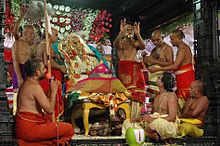Sita Ramachandraswamy Temple, Bhadrachalam
Often simply referred to as Bhadrachalam or Bhadragiri, Bhadradri, the temple is considered one of the Divya Kshetrams of Godavari and is also revered as Dakshina Ayodhya.Bhadrachalam follows the Vaishnavite Pancharatra Agama tradition, and its system of worship is modelled on that of the Ranganathaswamy temple in Srirangam.According to this legend, in the Treta Yuga, Rama (avatar of the god Vishnu), along with his consort Sita and brother Lakshmana, stayed in the Dandaka forest as a part of their fourteen-year exile.[1] Due to Rama's grace, a stone turned into a human called Bhadra, who was considered the son of Mount Meru.Pleased, Rama promised to return to meet Bhadra when he had found Sita, who had been abducted by the demon king Ravana.[2] Rama in upper arms held a shankha (conch) and the Sudarshana Chakra (discus) and a bow and an arrow in his lower hands.Some attribute the sanctum's statue with Rama with Sita seated in his lap and brother Lakshmana standing next to him to another local legend.This legend states that a tribal woman living in Bhadrareddypalem named Pokala Dhammakka found the central icon of Rama in an anthill.[6] During the reign of Abul Hasan Qutb Shah – the last Sultan of Golconda (1672-1686) – under his orders, Gopanna enforced the Jaziya religious tax, a penalty designed to force Hindus to adopt Islam.Gopanna explained that he never intended to misuse the treasury funds and planned to reimburse using donations he expected to receive in the future.[14][15] According to another myth published in Indian newspapers and local publications, the 15th century Kabirdas – a Muslim saint – toured Telangana singing bhakti songs of Rama.[8] According to the temple's history, after Gopana's death Tumu Lakshmi Narasimha Dasu of Guntur and his friend Varada Ramadasu of Kanchipuram offered prayers daily at Bhadrachalam and spent their life there.[24] On the top of the vimana of the sanctum is an eight-faced Sudarshana Chakra with a thousand corners, that was engraved by Gopanna, who found it lying in the waters of the Godavari River.In the centre, the Rama mada coins given to the Shah, jewellery made by Gopanna for the deities, and other important items are housed.The jewellery includes the chintaku patakam (a necklace studded with rubies), kirithas (crowns), plaited decorations, and a mutyala haramu (chain of pearls).[26] The suprabhata seva (pre-dawn ritual) begins early in the morning at 4:00 am, followed by providing Balabhoga (minor food offerings) from 5:30 to 7:00 am.[23] This ritual is also performed to the deities in the Lakshmi, Anjaneya, and Yogananda Narasimha temple exclusively on every Friday, Tuesday, and Saturday, respectively.[27] Kalyanam (marriage) and Thiruveedhi utsavam (procession festival) are performed at the Ranganayakula Gutta every year for its presiding deity Ranganatha.[3] The Agama text named Paramapurusha Samhita states that the devotees must watch Vishnu seated on the procession vehicle of Garuda proceeding from the North gate to fulfill their wish of gaining salvation.[3] As a prelude to Vaikuntha Ekadashi, Teppotsavam (the float festival) is celebrated during which a swan-shaped boat named Hamsavahanam is utilised for the procession of the utsava icons on the waters of the Godavari River.[35] The event begins with Vaishnava women gathering in the Chitrakoota mandapam hall in the temple's premises and participating in an initial prayer to the traditional grinding equipment.Dolotsavam (the swing ritual) is performed to conclude Vasanthotsavam by placing the festival icons in a golden cradle and singing lullabies.[23][37] Brahmotsavam is initiated by performing Visesha Snapanam (a special cleansing) of the festival icons followed by Ankurarpanam (the formal start), listening to the Panchangam dictation, and the Thiruveedhi utsavam.[37][38] The Dwajapata Bhadraka Mandala Lekhanam, a flag made of white cloth with an image of Garuda, is prepared, and special prayers are performed.[38] The Shah, after releasing Gopanna from jail, started the tradition of sending pearls and silk robes as gifts to Rama and Sita on the eve of the marriage conducted in the temple.[45] The key events of the Dussehra celebrations are the marriage and coronation of Rama followed by special prayers to his weapons and the Shami tree (prosopis cineraria).[47] After the completion of the yagna, Rama's idol is dressed like that of an emperor and is carried out in a procession on the vehicles of Gaja (elephant) and Aswa (horse).[48] Devotees mark the conclusion of their Hanuman Deeksha by untying the Irumudi (sacred bundle) before Rama and offering it at the Dasanjaneya temple.The Brahma Purana makes special mention of the temple's significance and adds that Vaikuntha Rama is capable of imparting knowledge to those who worship him at Bhadrachalam.[16] The annual tradition of giving pearls and silk robes to Rama on the day of his marriage celebrations has been replicated at many other smaller temples dedicated to the deity.







AffiliationHinduismBhadradri Kothagudem districtVasantha Paksha Prayukta Srirama Navami BrahmotsavamVaikuntha EkadashiVijayadashamiBhadrachalamTelanganaGeographic coordinatesKancherla GopannaHindu templeavatarVishnuGodavari RiverAyodhyacentral iconLakshmanaAbul Hasan Qutb ShahGolconda SultanatePancharatraRanganathaswamy templeBhajanRama NavamiTreta YugaDandakaMount MeruNaradaupadesammantraRavanashankhaSudarshana ChakrasalvationSabarimandapamBhadrachalam RamadasuNelakondapallitehsildarJaziyaKabirdasMuslimGunturKanchipuramKhammam districtGovernment of Andhra PradeshKalluri ChandramouliTelangana movementAndhra PradeshThirunamamsanctumdwajasthambampanchalohaGarudavehiclevimanafestival iconsSwayambhupadmasanaRanganathaLakshmi ThayarSrirangam Ranganathaswamy templeHanumanNarasimhaplaitedJalagam Vengala RaoRamayanaKuladevataIkshvaku dynastyPunarvasuAbhishekaBrahma PuranaGoda KalyanamMakar SankrantispringVaishnavatheerthamBrahmotsavamAbhijitPanchangamkalashassacred watermangala sutraDasharathaJanakaprosopis cinerariaVarunaKuberaRamlilaHanuman JayantimandalsMaha PushkaramPushkaramTyagarajacarnatic musicVijayanagara EmpireKrishnadevarayaVenkateswaraancestor worshipBrihaspatiJupiterAndhra JyothyThe Hans IndiaThe HinduOutlookThe TelegraphNamasthe TelanganaETV Andhra PradeshEenaduThe New Indian ExpressAndhra BhoomiBusiness StandardSriram, V.Taylor & FrancisShambhala PublicationsiUniverseAhobilamAnnavaramTirumalaDwaraka TirumalaSarpavaramSimhachalamMangalagiriGovindaraja Temple, TirupatiKodandarama Temple, TirupatiSrinivasamangapuramMandavya Narayana Temple